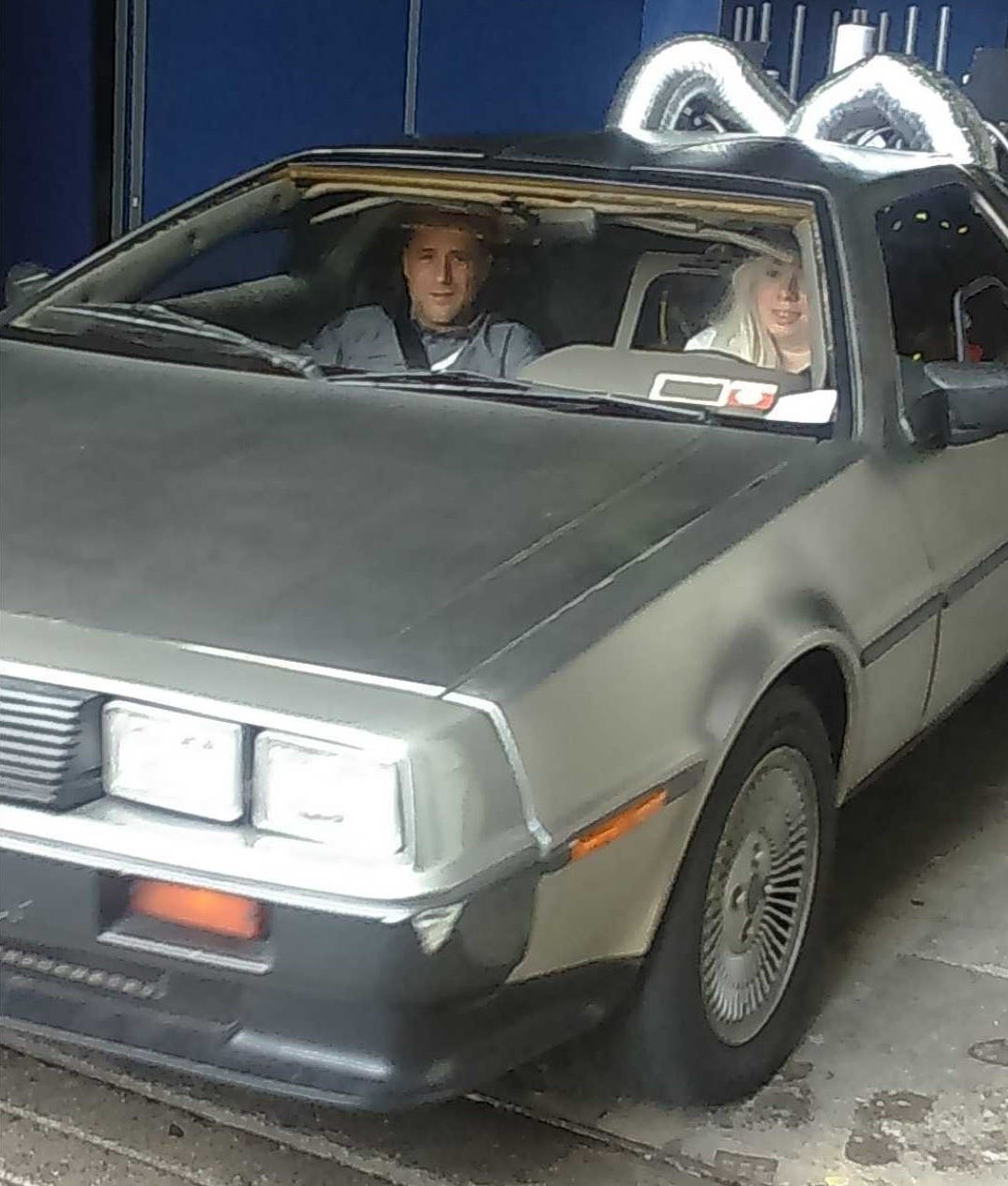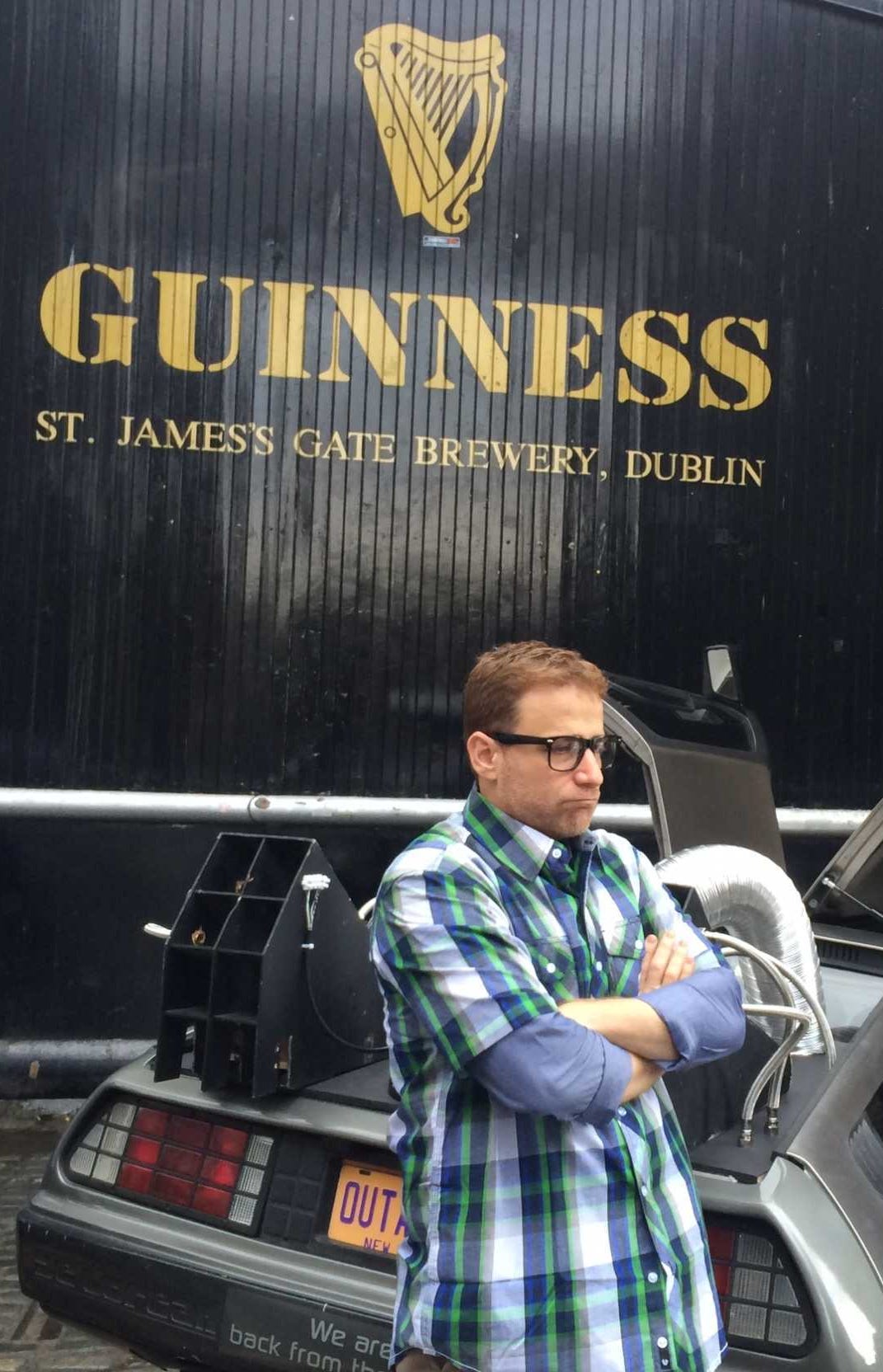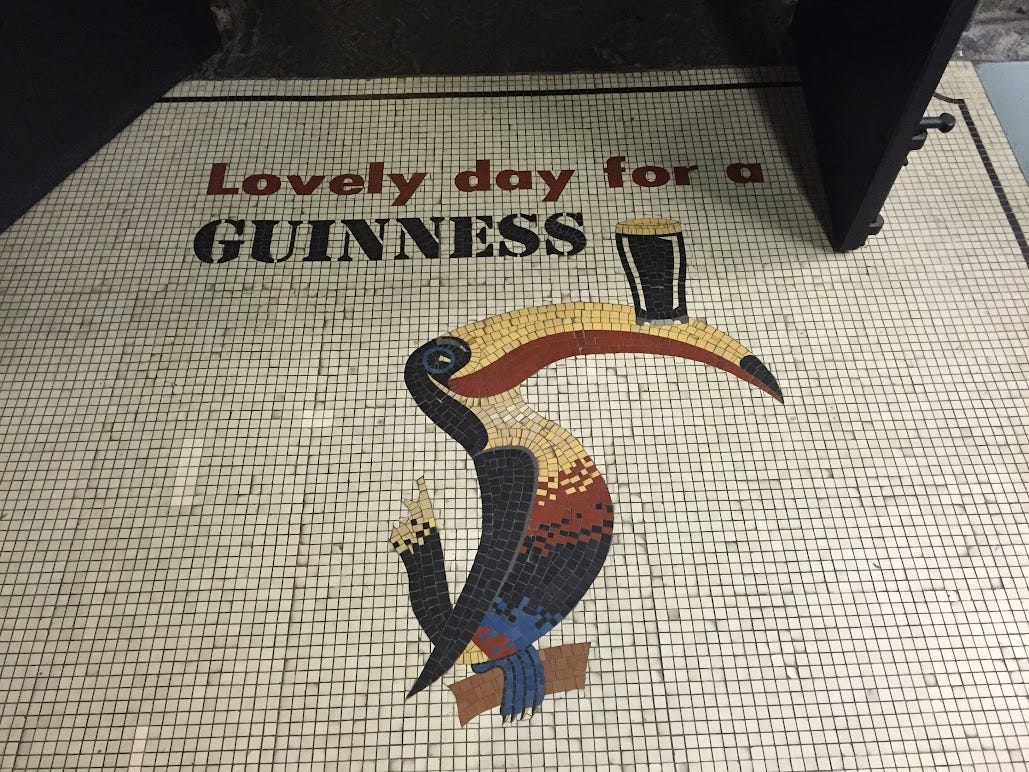A Very Stewart Visit to Dublin
Bossman comes calling. Wanting to show our set up success. Meeting his handlers. Celebrating back to the future.
Okay, let’s take a breath. We had established a Dublin office. We had a handful of terrific employees. We started humming along and getting into a groove as the first Slack office outside the Pacific time zone and North America, figuring out how to work on our own and teaching the HQ how to operate globally.
In short, we felt like we had something good going. Time for Stewart to come visit.
And did I mention is was Hallowe’en too? Yes. Hallowe’en wasn’t a big holiday in Ireland. Our family carved the only Jack O’ Lantern on our street. But our office was a different story. They latched on to Hallowe’en as a holiday and felt very dedicated to celebrating well.
Davina arrived in her restored, authentic DeLorean time machine, dressed as Doctor Emmet Brown from Back to the Future. Paul wore a costume that made it seem as if he rode a leprechaun. Naturally, Ciaran came dressed as a priest.
Expectations and Evaluations
Leading up to Stewart’s arrival, we wanted the visit to be great. Preparing felt like hosting a parent after you’d moved away from home to a new city. At least, that’s how it felt for me and Hanni.
We had been given a job as emissaries of Slack. We had ventured forth. We had done the first parts of the job and we felt we had done them pretty well. Now our work had set up an operation that could be blessed by a visit from Stewart. No one called the visit an evaluation, but it felt like an evaluation.
Personally, I also felt a sense of responsibility to show Stewart a good time because he didn’t need to come. He had so many things he could have been working on. I wanted to make sure Dublin cared for him well, and showed off the best versions of what we had worked hard to build.

We were Slack, and we were different. We had the same values and contributed to the team, and we had some weirdness to us as Slack Dublin. But we thought that weirdness fit in well with Slack overall. We had taken the model of what a Slack office could be and applied it to a new Dublin context. At least, that’s what we intended.
We worked with HQ on itineraries. Stewart had people now and they had expectations and processes and needed communication. Stewart’s time was tight. Travel to a destination meant speaking and meetings and PR all piled on for him, in addition to internal jobs he had to fulfill. During Stewart’s Dublin visit he would also be speaking on the main stage in front of thousands at the enormous Web Summit conference. Press briefings awaited to bolster our local profile for recruiting new employees. The shared calendar we all used felt like a surreal game of Tetris, fitting the commitment blocks into the open time spots.
As an added stress, we had the ambition to run a live, company-wide All Hands meeting from Slack Dublin. It was set to be the first time the meeting would be run from outside HQ in SF. Oh, and did I mention it was also the Slack celebration of Callowe’en?
All Hands Dublin
Have I been explicit enough in my description of the physical building we first occupied in Dublin, the Guinness Storehouse? It’s hard to emphasize how stony it was. How much like a dungeon it physically resembled.
The cart tracks that scored the streets of the neighbourhood continued into the hallways of our office space. In a few locations, happy Guinness parrots graced the tile floors.
A round-trip run to the bathroom and back took approximately 4 minutes for a full turn — down the stairs, through the halls, around the border to the sole location of plumbing in the building, then back. This was essential knowledge for not being late for calls.
The space was dark and gloomy and hard and cold. It was full of character and history and a terrible place to rely on wifi signals. As we discovered many times.
So preparing to run a video meeting live to the globe meant fixed-wire connections and external lighting and external mics and speakers. We prepared a week in advance yet still the infrastructure only came together at the last minute. We counted down to the meeting start time. Stewart arrived. We held our breath and connected our band of about 20 from Dublin to the rest of Slack around the world, about 200 strong.
And, surprisingly, it all went very well. Smoothly, you might even say. Much better than I had worried it would go.
The only moment of mild panic I remember was in Stewart’s closing remarks, saying so long from Dublin, and calling for me to come into frame, unprepared. He smiled at me, and said something like, “You’ve been here opening the office for a few months now, what have you learned about Slack from opening in Dublin?”
Oh, shit. I thought. This was unexpected. Did I blank on an answer? Did I run through a few inappropriate answers? Yes, probably, at first. I can’t remember. Either way, I took a beat to answer. Then I knew what I had to say: The people. We’d been able to find excellent people, just like we had all over the globe, just like we aspired to attract. They filled the room with us and connected remotely from around the world. And my answer also had the benefit of being true.
A few hours prior to the All Hands, Stewart and I had had a chance to chat. How were things going? What was new? He was asking about my life but what I noticed was his life. I started to see some of the many changes that lay on his path ahead and how his life was changing. He had assistants to act as handlers. He rarely did his own scheduling, though he certainly prioritized how he wanted to spend his time. He had become much more subject to the pulls of the rest of the organization.
One striking thing I remember him telling me reflected where he spent his time. He could see the changes coming too. He said that telling the Slack story had become 25% of his job externally, and 25% of his job internally. Half his job was now telling the Slack story.
Not the same story for everyone, but the broad Slack story tailored to different audiences’ needs. One story for recruiting. Another version for the press. Another for investors. Another for employees. A few finer-grained versions for smaller groups. This was half his time.
Did he love it? I’m not sure. I didn’t ask. He certainty did the job very well so I would guess he did really enjoy elements of it. He was comfortable and capable with people, on stage, on camera. And I realize that we were witnessing the emergence of him as a star: Stewart had become synonymous with Slack.
A Cult of Personality
Many years later, after I left Slack, I was walking with a former co-worker who knew Stewart reasonably well. I asked him: do you think Slack was a cult of personality?
Without missing a step, maybe even without taking another step, he said, right away, “Absolutely.” Then he qualified.
It may be that all startups are cults of personality, or at least cultures driven by a single vision. It may be that this single-mindedness is what makes them successful. He had started his own company a few times before so he had some experience to speak from. And it partially makes sense to me.
Let’s call it the One Mind theory. The ability to have a single focus from One Mind that gets percolated out to all the other contributors in a team seems essential for coherence of work. It means that decisions get made from a full team but in agreement with that One Mind. A work style is picked up from that One Mind. A product is built from that One Mind. And when the team feels they don’t know what that One Mind would think about something, they consult. They defer. They hedge and procrastinate. Certain judgements are housed in that One Mind. The organization grows to have faith in that One Mind.
Looking back at my own journey at Slack, I certainly felt an adherence to Stewart’s One Mind when I started talking to customers. I’d watched Stewart do it enough times. I described it to myself and others as ‘method Stewart,’ using the term from Method Acting, of an actor trying to fully become the character they played.
Stewart definitely drove Slack from the very beginning. His bio read for many years: Slack Boss. There was no ambiguity about it. His fingers touched so many parts of the business and the team trusted him with so much — trusted his judgement, his opinions, his feedback, his micro-managing, controlling nature. His One Mind, as we all imagined it.
I’m not saying Stewart was the Stalin of Slack. As far as I knew at the time and know now, he didn’t promote himself as the Dear Leader, held up as faultless and possessing the sole source of truth on all matters. He didn’t squash competitors to his vision. He took feedback well when it was well considered. He brought in complimentary players to round out areas where he didn’t have competences, and gave them a platform, and often supported them.
In fact, I think he recognized the phenomenon of his personality’s gravitational pull and, rather than concentrating it and making it more simple to pull in more power, he actively worked to make it more complex and diffuse. Read any of his writing or listen to any of his interviews and the thing he struggles with over and over is simplification, reduction, brevity. He rarely gives an easy answer. He asks a lot of his audience and tends to keep complicated things complicated.
Style and Substance
When Stewart did tell the Slack story in public, we almost always led with numbers and customers. When we talked with customers about Slack, we almost always led with their actual product usage. We routinely grounded our conversations in facts that could lead to claims and stories, instead of the other way around.
Why? Stewart had most journalists eating out of the palm of his hand. He could have made wild claims without substantiation (“Microsoft is stealing our trade secrets…” for example) and those claims would almost surely have been repeated and amplified in headlines. Why go through the trouble of keeping track of all the proof and shaping the story around it?
A few reasons, I think.
Stewart knew how to play a longer game. He didn’t just want the headlines. He wanted the headline and the credibility that could prove durable. He wanted the reputation that accrued over time through trust and an element of predictability and reliability.
Stewart didn’t feel like we needed to dumb down the story or sensationalize it. It was already sensational enough — The growth! The customers! The stories! Listen to or read any of his interviews and I think you’ll find he flatters the audience with long-winded answers that aren’t necessarily well rehearsed. He gives interviewers the credit to be able to deal with detail. He shades with nuance.
And all that outward trust existed inwardly to us at Slack as well. It felt like as a team and culture we had a distrust of hype without substance. That didn’t mean style wasn’t appreciated. Nope. It was necessary as well. We wanted style and substance. For inspiration, Stewart sometimes referred to the Italian word sprezzatura — “a kind of effortless grace, the art of making something difficult look easy, or maintaining a nonchalant demeanour while performing complex tasks.”
We aspired to make each part of Slack hold up to that high standard of sprezzatura. To hide the complexity and sweat and work until it was needed. To take care of things for customers until we required their attention, then to ask for it specifically and accurately. To think through the details and only surface the essentials.
The highest form of our work was combining style and substance and making it not look like work (or hype) at all.
And in reflecting on this whole approach, this set of values and the commensurate ways of approaching and doing work, I can see now clearly why so many people at Slack hated being acquired by Salesforce. Why they chafed at following Marc Benioff.
It felt like such a contrast to how we’d done things, and how we valued doing things. Salesforce held style over substance. Benioff prized a kind of opportunistic hucksterism, talking up fashionable trends to grab headlines and provide a veneer of innovation. It felt like a purposeful effort to divorce media stories from the mediocre reality of the Salesforce product. Ohana come lately.
At least, that’s my $0.02. Sorry, about that rant, a digression on a digression. I was long gone from Slack when Salesforce acquired them, so I’m just going on reports from folks who still worked at Slack that were mystified as their CEO announced the AI strategy. “There is no AI strategy,” they would say behind the scenes, then wonder if they were going to be laid off from Salesforce.
I miss Stewart’s long, digressive, wandering answers. I miss the intelligence they added to the world and assumed of the world. If that makes me an adherent to a cult of personality, then okay. It’s something to believe in.
Up next: Leaving Never Neverland — Growing up and growing apart. Finding our competence traps. Trading idealism for conformity. Becoming Sales.







I always enjoy the posts that are mostly about a person or people. Stewart is a compelling figure.